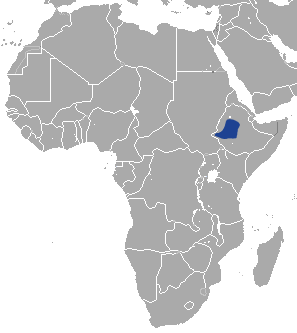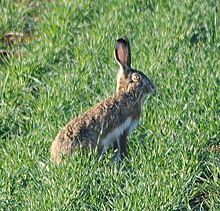
The mountain hare, also known as blue hare, tundra hare, variable hare, white hare, snow hare, alpine hare, and Irish hare, is a species of Palearctic hare that is largely adapted to polar and mountainous habitats.

The Arctic hare is a species of hare highly adapted to living in the Arctic tundra and other icy biomes. The Arctic hare survives with shortened ears and limbs, a small nose, fat that makes up close to 20% of its body, and a thick coat of fur. It usually digs holes in the ground or under the snow to keep warm and to sleep. Arctic hares look like rabbits but have shorter ears, are taller when standing, and, unlike rabbits, can thrive in extreme cold. They can travel together with many other hares, sometimes huddling with dozens or more, but are usually found alone, sometimes taking more than one partner. The Arctic hare can run up to 60 kilometres per hour (40 mph).

The European hare, also known as the brown hare, is a species of hare native to Europe and parts of Asia. It is among the largest hare species and is adapted to temperate, open country. Hares are herbivorous and feed mainly on grasses and herbs, supplementing these with twigs, buds, bark and field crops, particularly in winter. Their natural predators include large birds of prey, canids and felids. They rely on high-speed endurance running to escape predation, having long, powerful limbs and large nostrils.

The Cape hare, also called the brown hare and the desert hare, is a hare native to Africa and Arabia extending into India.

The antelope jackrabbit is a species of North American hare found in southern Arizona and northwestern Mexico that occupies dry desert areas.

The Japanese hare is a species of hare endemic to Japan. In Japanese, it is called the Nousagi, meaning "field rabbit".

The broom hare is a species of hare endemic to northern Spain. It was described in 1976 as separate from the Granada hare. It is classified as vulnerable by the IUCN.

The Indian hare, also known as the black-naped hare, is a common species of hare native to the Indian subcontinent, and Java. Its habitat in Java is in rocky highlands.

The Korean hare is a species of hare native to the Korean Peninsula and adjoining parts of northeastern China. The Korean hare inhabits diverse habitats within its range, from remote mountain forests to cultivated land. Fur colour varies slightly among individuals, but is generally some shade of liver brown.
The Majorcan hare is a subspecies of the Granada hare, from Majorca, Spain. It was described only in 1992. Most sources assume it is an extinct species.

The Yunnan hare is a medium-sized species of mammal in the family Leporidae. It has soft, flat, and long dorsal pelage which is grayish brown or dark gray in color, and whitish ventral pelage. It was considered endemic to China, but its presence was recorded in northern Myanmar in 2000. It is a herbivore, and forages on shrubs and forbs. It is rated as a species of least concern on the IUCN Red List of Endangered Species. The Red List of China's Vertebrates has listed the Yunnan hare as near threatened, almost meeting the criteria to be listed as vulnerable.

The Ethiopian hare is a species of mammal in the family Leporidae. It was first described in 1903, by the British mammalogist Oldfield Thomas. The dorsal pelage is brownish buff, and is finely grizzled with black. The ventral pelage is fluffy and white in colour. Endemic to Ethiopia, it is found in the Afromontane Biozone of Ethiopia, and in the borders of the Sudanian Savanna Biozone. It is rated as a least concern species by the International Union for Conservation of Nature.

The Alaskan hare, also known as the tundra hare, is a species of mammal in the family Leporidae. They do not dig burrows and are found in the open tundra of western Alaska and the Alaska Peninsula in the United States. They are solitary for most of the year except during mating season, when they produce a single litter of up to eight young. Predators include birds of prey and polar bears, as well as humans.

The Burmese hare is a species of mammal in the family Leporidae. It is found in Cambodia, Laos, Myanmar, Thailand, and Vietnam.

The Chinese hare is a species of mammal in the family Leporidae. It is found in China, Taiwan and Vietnam.

The Ethiopian highland hare or Starck's hare is a medium-sized species of mammal in the rabbit and hare family, Leporidae. Its dorsal pelage is grizzled, buff white and spotted and streaked with black, while its belly fur is pure white and fluffy. It is endemic to the Ethiopian Highlands, ranging over the Afroalpine regions of the Shoa, Bale, and Arsi Provinces of Ethiopia. A herbivore, it mostly feeds on moorland grasses. The IUCN rates it as a species of least concern.

The black-tailed jackrabbit, also known as the American desert hare, is a common hare of the western United States and Mexico, where it is found at elevations from sea level up to 10,000 ft (3,000 m). Reaching a length around 2 ft (61 cm), and a weight from 3 to 6 lb, the black-tailed jackrabbit is one of the largest North American hares. Black-tailed jackrabbits occupy mixed shrub-grassland terrains. Their breeding depends on the location; it typically peaks in spring, but may continue all year round in warm climates. Young are born fully furred with eyes open; they are well camouflaged and are mobile within minutes of birth, thus females do not protect or even stay with the young except during nursing. The average litter size is around four, but may be as low as two and as high as seven in warm regions.

The Corsican hare, also known as the Apennine hare or Italian hare, is a species of hare found in Southern Italy, Central Italy, and Corsica.



















